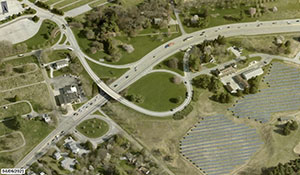Regulating Solar Power at the Municipal Level
Municipalities regulate the use and locational aspects of solar power through their zoning ordinance. The actual development of grid-scale solar facilities is regulated through subdivision and land development ordinances, and all new solar facilities will need to comply with local municipal building codes.
Zoning ordinances should differentiate solar power as an accessory use to a home or business and solar power that will be a power generating facility and the primary use on a property.

Residential and Commercial Scale Solar — Accessory Solar Systems
Zoning ordinances that address solar power as an accessory use, where the solar power is being used to power an individual home, commercial property, or institutional property should:
- Allow solar panels as an accessory use everywhere by right;
- Consider extra standards in historic districts that will protect historic views of a property. For example, solar panels could potentially be put on the back side of a historic property, which wouldn't change the view from the street;
- Have yard setbacks that match the setbacks for other accessory structures;
- For roof-mounted systems, prohibit system height from exceeding structure height on sloped roofs and allow the system height to exceed existing structure height by up to 15 feet on flat roofs;
- Encourage solar panels over parking areas, where they can provide shade and won’t consume open space;
- Exclude the panels themselves from the impervious coverage calculation when panels are located on pervious areas, with mounting poles and support equipment counting towards the impervious coverage calculation;
- Potentially encourage solar access agreements with neighbors, which guarantee access to the sun even though a neighboring property owner could block the sun by planting trees or constructing a building;
- Require utilities to be underground; and
- Include decommissioning and removal standards when located in yard areas.
Grid-Scale Solar — Solar as the Principal Use
Municipalities that want to encourage grid-scale solar facilities, where the solar facility is the principal use on a property, should carefully determine where in the community they should be allowed.
All communities should allow grid-scale solar power generating facilities in at least one location in the municipality, often as a power generation facility in the industrial district. Communities may want to encourage these elsewhere. In commercial non-residential districts, they will often be allowed by right. In residential, agricultural, and institutional districts, municipalities may only want to allow grid-scale solar as a special exception or conditional use when specific criteria are met. Some municipalities have scattered sites, perhaps brownfield sites or nonconforming industrial properties, and may want to allow these properties to be developed for grid-scale solar. These can be permitted as an overlay, provided properties meet certain locational criteria.
Zoning ordinances that allow solar power as a primary use, where the solar power is grid-scale and is generating power for the electric grid, should:
- Include limitations on development of prime agricultural soils, high quality natural areas, historic areas, and viewsheds;
- Prohibit advertising;
- Require tree preservation and have naturalized landscaped screening that fits into the community;
- Require facilities to comply with state regulations, have certified installers, and approval from PJM, which regulates connections to the electric transmission network;
- Require acknowledgement of the right of abutting property owners to grow trees;
- Include decommissioning and removal standards;
- Include the zoning district requirements for setbacks, height, and impervious coverage;
- Provide standards for proper access, which generally should come from higher classification roads; and
- Require fencing around the regulator/inverter/transformer equipment.
Local Model Standards
Bucks County — Model Alternative Energy Ordinance
Cumberland County Planning Commission — Solar Energy Systems Model Ordinance.
Delaware Valley Regional Planning Commission — Renewable Energy Ordinance Framework

